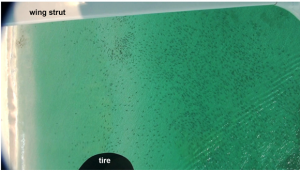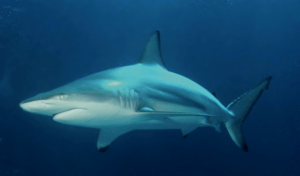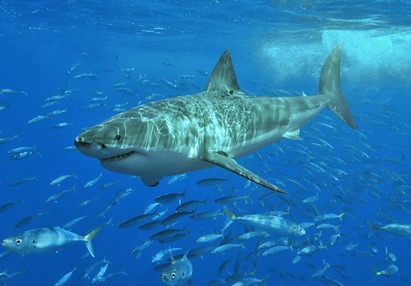The Greatest of Migrations
Nature boasts of many cool migrating species: monarch butterflies, penguins and salmon to name a few. But, perhaps one of the most unique and awe-inspiring migrations of them all occurs off the Southeastern coast of Florida. Every winter, tens of thousands of blacktip sharks gather along the coast of Palm Beach County as they all reach the southernmost destination of their seasonal migration, as seen in this stunning aerial photo.

What is a blacktip shark?
The blacktip shark (Carcharhinus limbatus), not to be confused with the blacktip reef shark (Carcharhinus melanopterus), is a medium-sized coastal shark found along the coast of the Southeastern United States. They are called blacktip sharks because of the characteristic dark edges along their fins (Figure 2). Although sometimes found offshore, they are most commonly found on or near insular (island) and continental shelves. They can get up to 2 meters long and feed on bony fishes, small elasmobranchs (sharks, skates and rays) and invertebrates. In addition to their impressive migration, blacktips also exhibit another unique behavior, parthenogenesis, which is a form of asexual reproduction in which an embryo grows from an unfertilized egg!

You’re on candid camera!
Dr. Stephen Kajiura of Florida Atlantic University and his team have been studying and quantifying the yearly aggregation of these impressive creatures since 2011. They use aerial biweekly surveys to take videos as they fly along the coast of Palm Beach County. Using this high-resolution video, they can count the number of sharks in the camera’s field of view to determine the abundance of blacktips in the area.
In their most recent paper, which analyzed data collected between 2011 and 2014, they found that the abundance of blacktips was highest between January and March. The highest number of blacktips counted in a survey was 12,128 sharks, which is approximately 803 sharks per square kilometer! Most of the sharks can be found between Boynton Inlet and Jupiter Inlet. The migrating blacktips are usually gone by April or May once the water starts to warm up, but while they are all there, it is a sight to behold (Figure 1).
Why Palm Beach?
Kajiura and Tellman propose that the blacktips aggregate so close to shore of Palm Beach because the continental shelf narrows significantly, which creates a natural bottleneck for the sharks that utilizes the shelf. The Gulf Stream also comes close to shore in this area, so the sharks would have to expend more energy swimming against the strong offshore current.
There are 2 smaller peaks in shark abundance along the East coast of central Florida, which suggests that the sharks are traveling from Northern Florida to Palm Beach County and back, using central Florida as a migration corridor. Kajiura and Tellman present several factors that may lead to this migration and large aggregation: feeding, thermoregulation (maintenance of appropriate body temperature), predator avoidance, or a combination of various factors. There is evidence to support all these factors: the migration aligns with the spawning of blacktip prey species, blacktip predators (larger sharks) move offshore, which could force blacktips inshore, and the blacktips begin moving into the area once the water temperature is below 25 degrees Celsius, which could be a result of the need to thermoregulate. However, there are some sharks that stay in the area year-round, which indicates that temperature is perhaps not the only factor.
Which sharks are migrating?
The fact that there are resident blacktips in the area year-round presents an interesting question: “Why don’t all blacktips migrate?” Kajiura and Tellman propose that the resident sharks may be non-mating females, for example females that are outside of reproductive ages, or females that are in the ‘resting’ phase and not mating that year. Alternatively, they suggest that the resident sharks could be a subpopulation of blacktips with a larger thermal tolerance that are better adapted to handle more extreme fluctuations in temperature and therefore don’t need to move to regulate their internal temperature. The average size of the sharks in the aggregation is 173.4 cm, which suggests that most sharks migrating are mature adults.
Blacktips and Humans
As you can imagine, this large aggregation of sharks gets a lot of media attention every year. Despite what the movie Jaws has led us to believe, sharks are not man-eating machines, and the blacktips pose minimal risk to humans. Many beaches close during the time of the aggregation, however, in an abundance of caution. But, if anyone is at risk, it’s the blacktips. blacktips are harvested in commercial and recreational fisheries for their meat. In fact, blacktips are the second most harvested shark in Florida. Regulations have been put in place to protect the sharks during this vulnerable time. During the months of the mass aggregation, harvesting of the species is limited to 1 shark per person or 2 sharks per vessel to prevent the species from being over-exploited.
In addition to fishing pressures, the Blacktips must contend with warming oceans, which will likely force a shift in migration time or aggregation location. This could have cascading effects on the ecosystem off the coast of Palm Beach County. There has already been preliminary evidence that the aggregation is decreasing in size, suggesting that Kajiura and his team will have more interesting data to gather as they continue to monitor the blacktips’ response to the changing climate. We can only hope the species will be able to adapt, but for now we can appreciate the greatest of migrations.
I am a Masters student in Biological Sciences at Florida State University. I received my B.S. in Marine Biology and B.A. in Spanish at the College of Charleston where I did a Bachelor’s Essay on the evolution of hammerhead sharks. For my current project I am tracking the movements of adult Smalltooth Sawfish along the coast of Florida. I also have an interest in coastal conservation and environmental education.


